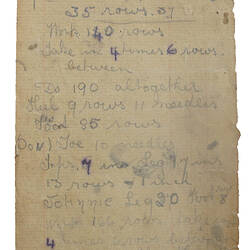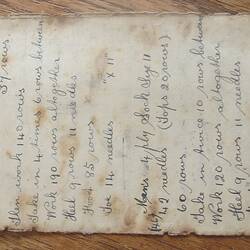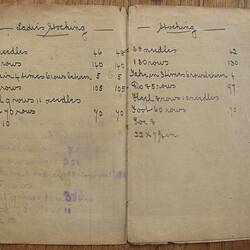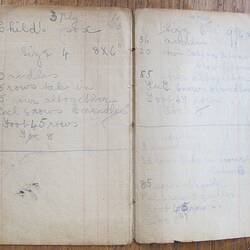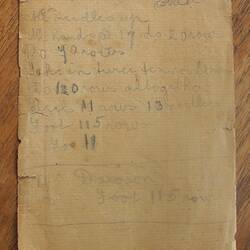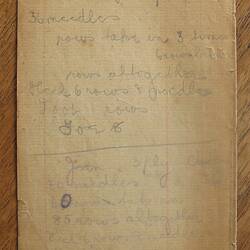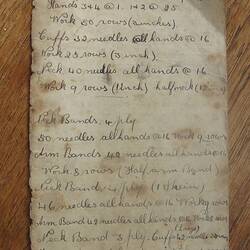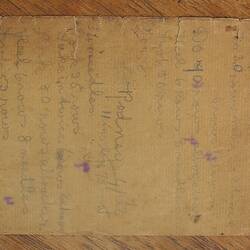Summary
Notebook and loose notes of patterns for use with the hand-powered flat-bed 'Preciosa' knitting machine manufactured by Wertheim (Germany) and retailed in Melbourne by Hugo Wertheim.
The knitting machine was purchased by the donor's grandmother, Ruby Fisher (1890-1958), from Hugo Wertheim in Bourke Street, Melbourne, in 1910. Ruby was a talented pianist who lived on a farm, 'Alisdale', in Yaragon, Gippsland, one of 11 children. She purchased the knitting machine when aged around 20, for the then considerable sum of 10 pounds 15 shillings. In its early years Ruby used the machine to make a range of items on commission, including boys' long socks, 'ladies stockings', 'socklets', 'jumper bands', singlets, neck and arm bands and even 'button holes'. She also made more complicated cardigans and jumpers. One of her notebooks lists items ordered and by whom, and what she charged - usually between two and five shillings per order. Her stamp appears in some of the notebooks: 'R. FISHER KNITTER' and 'ALISDALE YARRAGON'.
The machine was also used to knit socks for soldiers during World War I - according to the donor, a record 23 pairs of socks were knitted in a single day! Hand-written patterns for 'Soldiers Long Sox 3 ply' 'Soldier's Stocking' are included in the collection. The machine was probably also used to knit for World War II soldiers.
Physical Description
Notebook and loose notes, all in same format with pages lined on both sides and stapled (or have been) on side. All are yellowed, although some considerably darker, suggesting they may have come from another notebook or had a different pattern of use. The pages contain extensive hand-written patterns for a range of clothing. One page appears to be a cover for some of the patterns, and is labelled 'Socks / Miss R. Fisher / "Alisdale" / Yarragon'. Patterns following include 'Soldier's Stocking 4 ply', 'Soldier's Stocking Tops 48 Needles', 'Soldiers Long Sox 3 Ply', 'Man's Sock', 'Red Cross Golf Stocking', 'Ladies Stocking', etc. Some appear to be for clients, such as 'Mrs Farmers', 'Jack', 'Rodney' and 'Jean'. Of those pages still stapled, the orientation of the writing changes at the centre, and the book is read upside down, starting with 'Lady's Singlet'. This section includes a price list. A single loose black notebook cover accompanies the pages.
Significance
The knitting machine provides a relatively rare record of a woman's cottage industry in rural Victoria in the early 20th century, as well as being a significant item of material culture relating to work for the war effort on the home front during World Wars I and II. The machine collection includes a range of parts, manuals, users' notes, two garments and a (digital copy of a) photograph of a garment being worn, providing a comprehensive record of how the machine was used and for what purposes, and how this changed over time as a second user worked the machine.
Knitting machines were enthusiastically advertised in the media in the early 20th century when this model was purchased, both for making family clothing and as a means of earning money. Hugo Wertheim advertised knitting machines as 'One of the most profitable means by which to earn a livelihood or supplement an income IN YOUR OWN HOME' (The Age, 4/2/1911, page 2).
The first hand-powered flat-bed knitting machine was invented by the American William Isaac Lamb in 1863. The machine enabled rapid production of tube and rib-knitted fabric. It knitted in alternating plain and pearl stitches, providing a ribbed effect with high elasticity that looked the same on both sides. The year after its invention, Lamb's flat-bed knitting machine was improved by another American, Henry J. Griswold. Sold under the names 'Climax', 'Crane' and 'Little Rapid', the machines were used in the cottage industry to make men's socks and children's stockings. With further improvements in the machine's design, circular-knit stockings could also be made.
In Europe, manufacturer Henri Eduard Dubied saw the flat-bed machine displayed at the World Expo in Paris in 1867. He bought the patent and began to make the machines, which he called the 'Trikoteuse Omnibus', in his own Swiss factory. By the end of the decade French and German manufacturers, including Laue und Timaeus (later Irmscher & Co., Dresden) were also making flat-bed machines. In 1888 the invention of the tubular cam by G. F. Grosser in Markersdorf allowed heels to also be knitted by the flat-bed machines. Later developments facilitated the production of patterned goods and the use of an electric motor.
The Lamb Corporation remains in business to this day.
More Information
-
Collecting Areas
Working Life & Trades, Sustainable Futures, Public Life & Institutions, Clothing & Textiles
-
Acquisition Information
Donation from Raema Edgington
-
Date Purchased
-
Retailer
Hugo Wertheim, 294-296 Bourke Street, Melbourne, Victoria, Australia, 1910
-
Author
-
Inscriptions
Extensive
-
Classification
-
Category
-
Discipline
-
Type of item
-
Overall Dimensions - Closed
96 mm (Width), 164 mm (Height)
Sizes when closed. When opened to a double page the dimensions are: H: 164 mm x 192 mm
-
References
German Hosiery Museum, [Link 1] accessed 14/6/2012 Wonseok Choi, 'Three Dimensional Seamless Garment Knitting on V-Bed Flat Knitting Machines', Journal of Textile and Apparel, Technology and Management, vol.4, no.3, Spring 2005 Alex L. Askariffm Sewalot web site [Link 2] accessed 15/6/2012 'Hugo Wertheim', Australian Dictionary of Biography, [Link 3] accessed 15/6/2012
-
Keywords
Handcrafts, World War I, 1914-1918, World War II, 1939-1945, Manufacturing, Home Workers, Work in the Home, Knitting Machines, Knitting Patterns, Rural Life, Rural Women, Domestic Work, Soldiers' Comforts

